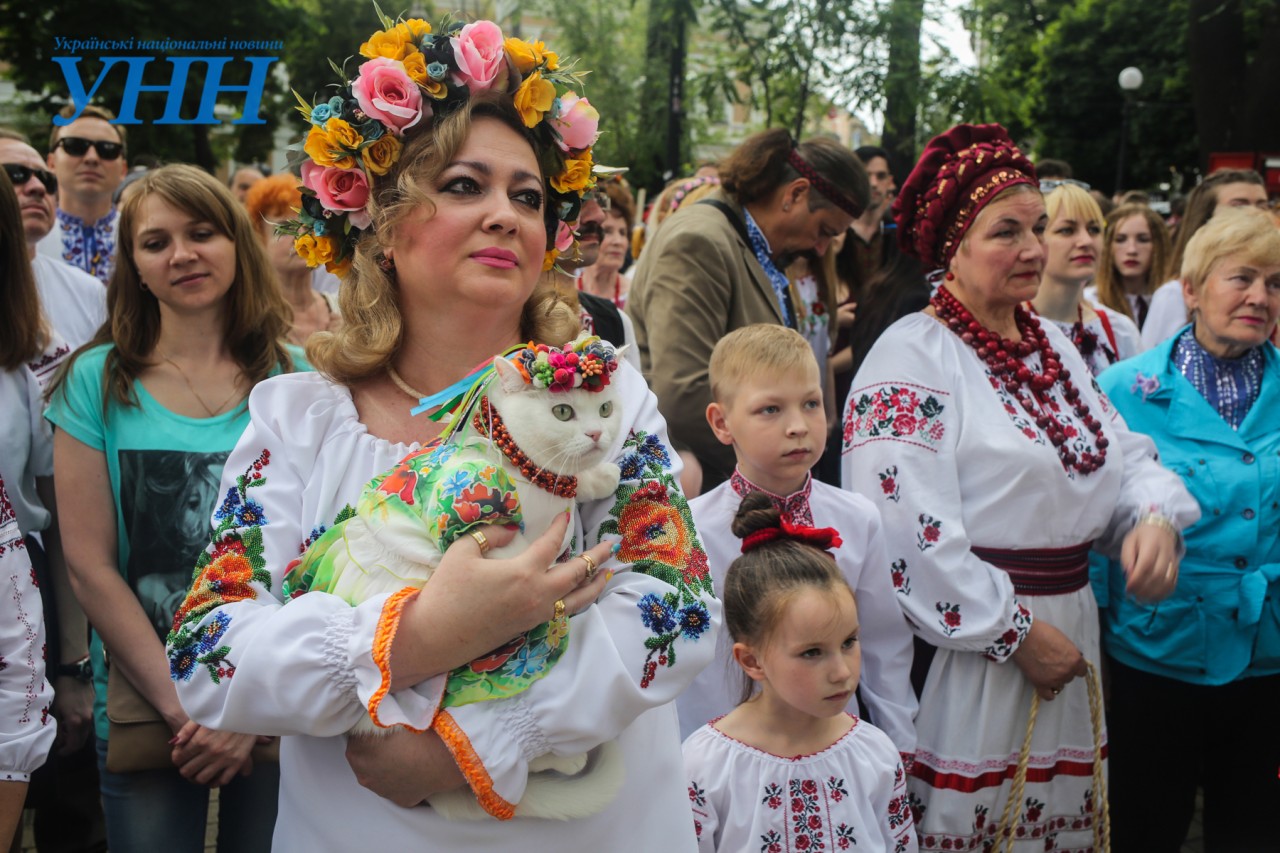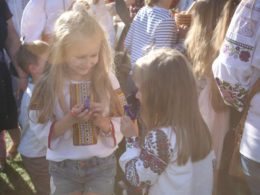How very colourful and varied the contemporary vyshyvanka! It can be one colour or many-coloured, richly or delicately patterned, embroidered with flowers or geometric forms... But, do we actually know what these intricate patterns adorning our clothes mean, how ancient their origins are, what they symbolize and why they are the way they are?
“The embroidered shirt had six different-sized squares interconnected by crosses usually stitched with black thread to prevent any foreign spirit from entering the human body. In fact, crosses were known to “split” or eliminate negative energy, whereas black colours absorbed it. Sacred codes of power and strength were embroidered on the chest and sleeves: for little children they were coded in plant ornaments, symbolizing the tree of life, in star amulets or in simple wavy lines with dots, symbolizing the raw force of nature - water and fire.”Delicate female hands have transferred these sacred codes onto white linen since days of yore, from generation to generation to the present, so reproducing and preserving the sacred powers of the family, the energy of nature and the divine origin of man and nature. The Ukrainian embroidered shirt is revered and respected for these very reasons, worn proudly during feasts, celebrations… and at all times.
1. Circles
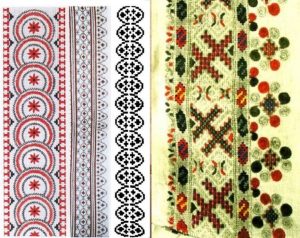 We know that the most ancient symbols are simple geometric designs. The circle is one of the primary signs. It represents the Sun, originating in pagan religions, where it embodies divine, life-giving energy. The circle also refers to the continuity of life and eternity. Overall, this symbol can be portrayed in many different ways and has many meanings. A circle with a dot in the middle portrays the centre of the universe; in Ukrainian symbolism, it is also a symbol of the Sun. The circle is a symbol of divine purity worn as a wreath by the bride. The circle is the Sun surrounded by bright rays diverging outwards that bestow strength and energy. However, sun rays that converge inwards capture and imprison energy so such a circle can symbolize emptiness.
The circle can be found in embroidery (but more on carved wooden articles and pysankas), usually in conjunction with other figures as part of a more complex pattern. We can see circles in the tree of life, particularly in traditional wedding towels.
We know that the most ancient symbols are simple geometric designs. The circle is one of the primary signs. It represents the Sun, originating in pagan religions, where it embodies divine, life-giving energy. The circle also refers to the continuity of life and eternity. Overall, this symbol can be portrayed in many different ways and has many meanings. A circle with a dot in the middle portrays the centre of the universe; in Ukrainian symbolism, it is also a symbol of the Sun. The circle is a symbol of divine purity worn as a wreath by the bride. The circle is the Sun surrounded by bright rays diverging outwards that bestow strength and energy. However, sun rays that converge inwards capture and imprison energy so such a circle can symbolize emptiness.
The circle can be found in embroidery (but more on carved wooden articles and pysankas), usually in conjunction with other figures as part of a more complex pattern. We can see circles in the tree of life, particularly in traditional wedding towels.
2. Squares
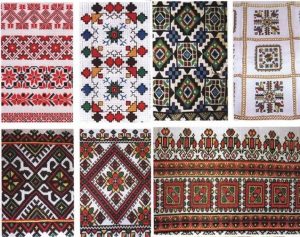 This figure is one of the central ornamental designs in many cultures. It symbolizes perfection, harmony and order. A square with a cross, often embroidered on men’s shirts, symbolizes an “earthly field”. In Ukrainian traditions, the Earth is often portrayed as a square. This figure is perfectly divided into equal portions (fields). Spiritually, the square symbolizes Matter, whereas the circle is perfection, i.e. the Spirit. Thus, the circle is contrary to the square. The square also stands for Number Four, which Ukrainians recognize as the symbol for the primary elements: the four cardinal points, the four seasons, the four parts of life cycle, the four parts of the day...
In embroidery, squares can be arranged in series or as part of more complex elements.
This figure is one of the central ornamental designs in many cultures. It symbolizes perfection, harmony and order. A square with a cross, often embroidered on men’s shirts, symbolizes an “earthly field”. In Ukrainian traditions, the Earth is often portrayed as a square. This figure is perfectly divided into equal portions (fields). Spiritually, the square symbolizes Matter, whereas the circle is perfection, i.e. the Spirit. Thus, the circle is contrary to the square. The square also stands for Number Four, which Ukrainians recognize as the symbol for the primary elements: the four cardinal points, the four seasons, the four parts of life cycle, the four parts of the day...
In embroidery, squares can be arranged in series or as part of more complex elements.
3. The Tree of Life
 This symbol is found in national art where the universe contains three components: the underworld, the earthly world and the heavenly kingdom. The tree depicts roots - the past, the trunk – the present, and the crown - the future. In Ukrainian embroidery this symbol can be recognized not only in the branches (they can be either symmetrical or asymmetrical), but also in wheat stalks, sheafs, twigs or vines. The tree of life holds the truth and unity of the three worlds and reflects the image of life and the family. There are more intricate compositions where the tree motif is replaced by a female image – a woman with raised arms. This is the Great Goddess or Original Mother, the embodiment of life itself.
Embroidered tree patterns are mostly found on large three-to-four metre traditional embroidered towels that decorate homes and churches. They are commonly found in Central Ukraine.
This symbol is found in national art where the universe contains three components: the underworld, the earthly world and the heavenly kingdom. The tree depicts roots - the past, the trunk – the present, and the crown - the future. In Ukrainian embroidery this symbol can be recognized not only in the branches (they can be either symmetrical or asymmetrical), but also in wheat stalks, sheafs, twigs or vines. The tree of life holds the truth and unity of the three worlds and reflects the image of life and the family. There are more intricate compositions where the tree motif is replaced by a female image – a woman with raised arms. This is the Great Goddess or Original Mother, the embodiment of life itself.
Embroidered tree patterns are mostly found on large three-to-four metre traditional embroidered towels that decorate homes and churches. They are commonly found in Central Ukraine.
4. Lozenges/Diamonds
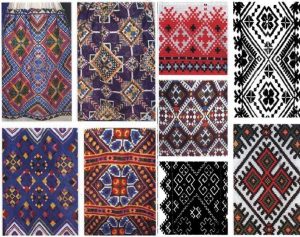 The lozenge is an archaic shape tied to human fertility and land. The male and female principles serve as the basis for deciphering the meaning of this symbol. It consists of two triangles. But, the most interesting thing is that in the ancient pre-modern Ukrainian period, it was believed that the woman held the three corners of the lozenge (the three corners of the home), while the man held the fourth, which completed the integrity of the family. A lozenge with a dot in the middle symbolizes a sown field, which was extremely important for our ancestors. It meant abundance and prosperity.
The lozenge is often called the Trypillian square – a kind of harrow that smooths the surface of the soil and prepares it for sowing. In addition to simple lozenges, we often see rhombuses with hooks (tiny horns) in Ukrainian embroidery. This design is called “zhaba” (toad) and symbolizes fertility. In ancient beliefs, this little creature was linked to heavenly moisture that gives life.
Lozenge-shaped patterns were embroidered on wedding towels and bridal gowns. Pregnant woman wore shirts covered with diamond patterns until childbirth as this symbol served as a powerful talisman.
The lozenge is an archaic shape tied to human fertility and land. The male and female principles serve as the basis for deciphering the meaning of this symbol. It consists of two triangles. But, the most interesting thing is that in the ancient pre-modern Ukrainian period, it was believed that the woman held the three corners of the lozenge (the three corners of the home), while the man held the fourth, which completed the integrity of the family. A lozenge with a dot in the middle symbolizes a sown field, which was extremely important for our ancestors. It meant abundance and prosperity.
The lozenge is often called the Trypillian square – a kind of harrow that smooths the surface of the soil and prepares it for sowing. In addition to simple lozenges, we often see rhombuses with hooks (tiny horns) in Ukrainian embroidery. This design is called “zhaba” (toad) and symbolizes fertility. In ancient beliefs, this little creature was linked to heavenly moisture that gives life.
Lozenge-shaped patterns were embroidered on wedding towels and bridal gowns. Pregnant woman wore shirts covered with diamond patterns until childbirth as this symbol served as a powerful talisman.
5. Triangles
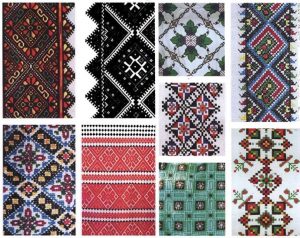 In ancient beliefs, the triangle symbolized the narrow gate that leads to eternal life. It was also the symbol of unity of the three worlds: the Earth, the Underworld and the Heavens (spiritual world). It represents the three elements - water, fire and air, the three levels of being and the Holy Trinity (in later Christian belief). The triangle has long been associated with Fire. Some researchers believe that the Ukrainian tryzub (trident) is a modern variation of the ancient triangle.
Triangles, whose tips touch each other, call to mind an hourglass, symbolizing the World and Anti-world. The meeting or touching point symbolizes the place of transition from one world to another. Sometimes, there is a line between the triangles. It is called the “Ring of Great Light”, which symbolizes a mirror where one world is reflected in another and vice versa. Such symbols are often found on embroidered towels in Middle Dnipro regions and Slobozhanshchyna.
In ancient beliefs, the triangle symbolized the narrow gate that leads to eternal life. It was also the symbol of unity of the three worlds: the Earth, the Underworld and the Heavens (spiritual world). It represents the three elements - water, fire and air, the three levels of being and the Holy Trinity (in later Christian belief). The triangle has long been associated with Fire. Some researchers believe that the Ukrainian tryzub (trident) is a modern variation of the ancient triangle.
Triangles, whose tips touch each other, call to mind an hourglass, symbolizing the World and Anti-world. The meeting or touching point symbolizes the place of transition from one world to another. Sometimes, there is a line between the triangles. It is called the “Ring of Great Light”, which symbolizes a mirror where one world is reflected in another and vice versa. Such symbols are often found on embroidered towels in Middle Dnipro regions and Slobozhanshchyna.
6. Chevrons
 We often see figures resembling triangles in ancient Ukrainian embroidery. These are chevrons, open triangles. Chevrons pointing downward refer to femininity or the material side, while those pointing upward refer to masculinity or spiritual side. Chevrons pointing downward also refer to the woman’s loins, the receptacle where new life is created and born.
Linear chevron designs look like a jagged pattern, a broken ribbon with rhythmic gradation. A chevron where the lines intersect at the top is one of the oldest ornamental symbols found in Paleolithic images symbolizing a mountain or the Earth. Ancient towels embroidered with chevron symbols were commonly found in Chernihiv Region.
We often see figures resembling triangles in ancient Ukrainian embroidery. These are chevrons, open triangles. Chevrons pointing downward refer to femininity or the material side, while those pointing upward refer to masculinity or spiritual side. Chevrons pointing downward also refer to the woman’s loins, the receptacle where new life is created and born.
Linear chevron designs look like a jagged pattern, a broken ribbon with rhythmic gradation. A chevron where the lines intersect at the top is one of the oldest ornamental symbols found in Paleolithic images symbolizing a mountain or the Earth. Ancient towels embroidered with chevron symbols were commonly found in Chernihiv Region.
7. Spirals
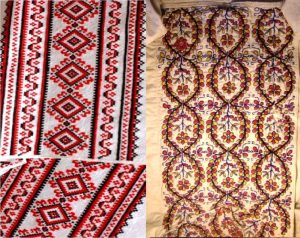 Wavy lines, sigmas and zigzags represent water. Researchers note that an image of vertically arranged parallel zigzags means rain that falls from above, while horizontal zigzags or straight lines can symbolize heavenly moisture. The spiral also refers to the fluidity of time and the cyclical movement of the solar disk. Our ancestors saw the spiral as a schematic image of the evolution of the Universe, its infinity. Even the structure of human DNA is similar to this pattern: each cell displays the life-giving flow of matter and energy.
Ancient embroidery had so-called Trypillian spirals - a circle or semicircle that gradually increased in diameter.
Wavy lines, sigmas and zigzags represent water. Researchers note that an image of vertically arranged parallel zigzags means rain that falls from above, while horizontal zigzags or straight lines can symbolize heavenly moisture. The spiral also refers to the fluidity of time and the cyclical movement of the solar disk. Our ancestors saw the spiral as a schematic image of the evolution of the Universe, its infinity. Even the structure of human DNA is similar to this pattern: each cell displays the life-giving flow of matter and energy.
Ancient embroidery had so-called Trypillian spirals - a circle or semicircle that gradually increased in diameter.
8. Crosses
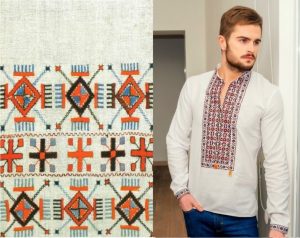 The cross (including its various modifications) is generally one of the most popular figures in world culture. It is multifaceted and inexhaustible and, unlike the circle and the square, symbolizes centricity and not the separation of space.
Interestingly, a straight cross symbolizes the Sun, the Creator and masculinity. An oblique cross personifies femininity and the Moon. When these two figures are superimposed, they form a double cross, or an eight-pointed star - the symbol of union between two entities. It is known that in pre-Christian times the cross served as a talisman against evil spirits. Two intersecting lines symbolize the meeting of the Earthly and Heavenly. The cross also points to harmony of the four elements: fire, water, earth and air. A cross in a circle is the astrological symbol for the Earth.
The cross (including its various modifications) is generally one of the most popular figures in world culture. It is multifaceted and inexhaustible and, unlike the circle and the square, symbolizes centricity and not the separation of space.
Interestingly, a straight cross symbolizes the Sun, the Creator and masculinity. An oblique cross personifies femininity and the Moon. When these two figures are superimposed, they form a double cross, or an eight-pointed star - the symbol of union between two entities. It is known that in pre-Christian times the cross served as a talisman against evil spirits. Two intersecting lines symbolize the meeting of the Earthly and Heavenly. The cross also points to harmony of the four elements: fire, water, earth and air. A cross in a circle is the astrological symbol for the Earth.
9. Swargas
 Commonly known as the swastika, the swarga is a cross in motion. It is a symbol of sun worship, whose magical powers many ancient peoples revered. In ancient Ukrainian history, it was associated with the hearth and home and family fortune. The swarga can be left- or right-facing. A right-facing swarga refers to the movement of the sun . A left-facing swarga was thought to symbolize a spiritual flame.
Quite often in Ukrainian embroidery (especially on the Right Bank of the Dnipro) we see the so-called complete swarga (a left-facing swastika superimposed on a right-facing one). In Ukrainian folklore it is called a “krutorizhka” (twisted hornlet) - a symbol of harmony created by two equal flowing lines. In Ukrainian embroidery, it is known as “koliadnyk” - a symbol of unity with ancestral wisdom. The swarga is a very ancient symbol of strength and energy.
Commonly known as the swastika, the swarga is a cross in motion. It is a symbol of sun worship, whose magical powers many ancient peoples revered. In ancient Ukrainian history, it was associated with the hearth and home and family fortune. The swarga can be left- or right-facing. A right-facing swarga refers to the movement of the sun . A left-facing swarga was thought to symbolize a spiritual flame.
Quite often in Ukrainian embroidery (especially on the Right Bank of the Dnipro) we see the so-called complete swarga (a left-facing swastika superimposed on a right-facing one). In Ukrainian folklore it is called a “krutorizhka” (twisted hornlet) - a symbol of harmony created by two equal flowing lines. In Ukrainian embroidery, it is known as “koliadnyk” - a symbol of unity with ancestral wisdom. The swarga is a very ancient symbol of strength and energy.
10. Keys or Sigmas
 Embroiderers in different regions of Ukraine referred to this motif in different ways: in Podillia they were called “hesyky” (S-figures), in Dnipro regions – “klyuch” (keys) and elsewhere “vuzhi” (snakes). The shape resembles a half swastika or half of the figure Eight. Therefore, it was seen as “the road to perfection”. The S-figure is a wavy line, a symbol of “heavy” earthly waters, the maternal moisture of the Earth that gives life to fields and crops. Shirts embroidered with “key” symbols were said to protect human energy from negative influences.
Researchers say that in ancient times sigma signs also symbolized a snake, which is associated with water. The serpent was the the guardian of the Underworld and symbolized man’s essence, fertility and fertilization. It often appeared as lightning in a dark rainy sky. In Podillia, women’s shirts were embroidered with rows of sigmas, which had the power to protect womanhood and maternity.
Embroiderers in different regions of Ukraine referred to this motif in different ways: in Podillia they were called “hesyky” (S-figures), in Dnipro regions – “klyuch” (keys) and elsewhere “vuzhi” (snakes). The shape resembles a half swastika or half of the figure Eight. Therefore, it was seen as “the road to perfection”. The S-figure is a wavy line, a symbol of “heavy” earthly waters, the maternal moisture of the Earth that gives life to fields and crops. Shirts embroidered with “key” symbols were said to protect human energy from negative influences.
Researchers say that in ancient times sigma signs also symbolized a snake, which is associated with water. The serpent was the the guardian of the Underworld and symbolized man’s essence, fertility and fertilization. It often appeared as lightning in a dark rainy sky. In Podillia, women’s shirts were embroidered with rows of sigmas, which had the power to protect womanhood and maternity.
11. Mallows or Eight-Pointed Stars
 The mallow or eight-pointed star is formed by superimposing a straight cross (symbol of masculinity and the Sun) and an oblique cross (symbol of femininity and the Moon). The joining of these two entities naturally gives life. The full mallow is also known as the Mother’s Star. This is the symbol we often see in icons of the Virgin Mary.
The octagonal star is one of the most popular geometric motifs in Ukrainian embroidery. Eight is not a haphazard number. Biophysicists say that such a star - octahedron – is the model of an energy field built around any living organism. The human zygote undergoes its first cell division, forming eight cells, eight energy flows, which then shape the physical and spiritual essence of the embryo.
The mallow or eight-pointed star is formed by superimposing a straight cross (symbol of masculinity and the Sun) and an oblique cross (symbol of femininity and the Moon). The joining of these two entities naturally gives life. The full mallow is also known as the Mother’s Star. This is the symbol we often see in icons of the Virgin Mary.
The octagonal star is one of the most popular geometric motifs in Ukrainian embroidery. Eight is not a haphazard number. Biophysicists say that such a star - octahedron – is the model of an energy field built around any living organism. The human zygote undergoes its first cell division, forming eight cells, eight energy flows, which then shape the physical and spiritual essence of the embryo.
12. Winding Dance Lines
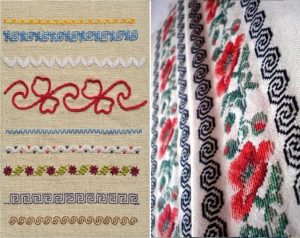 This motif is also called “bezkonechnyk” (infinite line) or meander. The word “meander” comes from the Greek describing the Meander River in Türkiye. Scholars have shown that this symbol was popular on the territory of Ukraine more than 20,000 years ago. In ancient Ukrainian traditions, its soft curves are also associated with water, a harmonious flow of life. It forms an infinite pattern that winds its way like the thread of fate, but always comes back to the source. It depicts the road of life and represents eternal life.
This motif is called the “winding dance” as it is closely connected with the ritual dance that Ukrainian girls traditionally perform in spring, charging the Earth with their graceful movements. The “infinity” symbol is often found in Hutsul, Volyn, Kyiv, Poltava and Kuban regional embroideries. Meander patterns usually decorate men’s shirts, symbolizing and bestowing strength and vitality.
Embroidery photos courtesy of folk.moda.net
This motif is also called “bezkonechnyk” (infinite line) or meander. The word “meander” comes from the Greek describing the Meander River in Türkiye. Scholars have shown that this symbol was popular on the territory of Ukraine more than 20,000 years ago. In ancient Ukrainian traditions, its soft curves are also associated with water, a harmonious flow of life. It forms an infinite pattern that winds its way like the thread of fate, but always comes back to the source. It depicts the road of life and represents eternal life.
This motif is called the “winding dance” as it is closely connected with the ritual dance that Ukrainian girls traditionally perform in spring, charging the Earth with their graceful movements. The “infinity” symbol is often found in Hutsul, Volyn, Kyiv, Poltava and Kuban regional embroideries. Meander patterns usually decorate men’s shirts, symbolizing and bestowing strength and vitality.
Embroidery photos courtesy of folk.moda.net
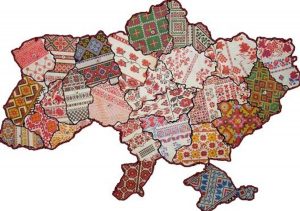
Related:
- Top five national symbols of Ukraine
- Legendary Borshchivsky embroidery
- Ukrainian neck ornaments: History and symbols
- Flowers and ribbons in the Ukrainian vinok
- Legend of the vyshyvanka (traditional Ukrainian embroidered shirt)
- 5 ways to wear Ukrainian vyshyvanka
- Vyshyvanka Day 100 years ago and today: interactive map of Ukrainian embroidered shirts
- Hollywood Stars opened their "Parad of Embroidery"
- Graduates of gymnasium in Crimea's occupied Sevastopol come to graduation ceremony wearing vyshyvankas (PHOTO REPORT)
- Activists detained in Moscow for wearing clothing with Ukrainian symbols
- 8 of the most popular Russian stereotypes about Ukraine


